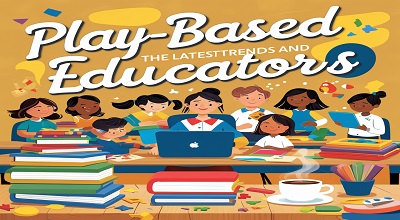Play-Based Learning for Educators
Play-Based Learning for Educators: Play-based learning is an educational approach that integrates play into the learning process to foster creativity, critical thinking, and social-emotional development. As educators seek innovative ways to engage students, play-based learning has gained significant traction in modern classrooms.
What is Play-Based Learning?
Play-based learning is an educational methodology where children learn through play, guided by their natural curiosity and interests. Unlike traditional rote learning, this approach emphasizes exploration, experimentation, and hands-on activities.
Types of Play-Based Learning
- Free Play: Unstructured play where children choose activities independently.
- Guided Play: Play with teacher facilitation to meet learning objectives.
- Games-Based Learning: Using educational games to reinforce concepts.
This approach is widely used in early childhood education but is increasingly being adopted in primary and secondary education for its engagement benefits.
The Science Behind Play-Based Learning
Research in neuroscience and developmental psychology supports play-based learning as a crucial element in cognitive and social development.
Key Findings:
- Play stimulates brain plasticity, enhancing memory and problem-solving skills.
- Social play improves emotional regulation and teamwork.
- Hands-on activities strengthen fine and gross motor skills.
Studies from Harvard’s Center on the Developing Child confirm that play-based environments lead to better academic and behavioral outcomes.
Latest Trends in Play-Based Learning
The field of play-based learning is evolving with new trends:
A. Technology-Integrated Play
- Use of educational apps, AR/VR, and gamification to enhance engagement.
- Example: Minecraft Education Edition for collaborative problem-solving.
B. Outdoor and Nature-Based Play
- Schools are incorporating forest schools and outdoor classrooms for experiential learning.
C. Social-Emotional Learning (SEL) Through Play
- Role-playing and cooperative games to teach empathy, conflict resolution, and resilience.
D. Inclusive Play-Based Learning
- Adapting play activities for children with disabilities to ensure accessibility.
Strategies for Implementing Play-Based Learning
A. Designing a Play-Based Classroom
- Create learning centers (e.g., reading corner, art station, block area).
- Use open-ended materials (blocks, clay, loose parts) to encourage creativity.
B. Balancing Structure and Freedom
- Combine guided play with free exploration to meet curriculum goals.
C. Assessing Play-Based Learning
- Use observation checklists, portfolios, and student reflections instead of traditional tests.
D. Engaging Parents and Community
- Host play workshops to educate parents on the benefits of play-based learning.
Benefits of Play-Based Learning
| Benefit | Description |
|---|---|
| Enhanced Creativity | Encourages imagination and innovation. |
| Improved Social Skills | Promotes teamwork and communication. |
| Stronger Cognitive Abilities | Boosts problem-solving and critical thinking. |
| Emotional Resilience | Helps children manage stress and emotions. |
Challenges and Solutions
Common Challenges:
- Resistance from traditional educators
- Lack of resources
- Assessment difficulties
Solutions:
- Provide teacher training on play-based pedagogy.
- Use low-cost materials (recycled items, nature-based tools).
- Implement alternative assessment methods (e.g., storytelling, project-based evaluations).
Case Studies: Success Stories
A. Finland’s Play-Based Model
- Finnish schools integrate play into formal education, leading to high PISA rankings.
B. An Australian School’s Transformation
- A primary school saw improved attendance and engagement after shifting to play-based learning.
FAQs on Play-Based Learning
Q1: Is play-based learning only for young children?
No, it can be adapted for all ages with age-appropriate activities.
Q2: How does play align with curriculum standards?
Play can be structured to meet literacy, math, and science objectives through guided activities.
Conclusion
Play-based learning is a powerful, research-backed approach that fosters holistic development in students. By embracing the latest trends and strategies, educators can create dynamic, engaging classrooms that prepare children for lifelong success.
